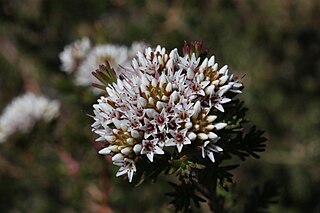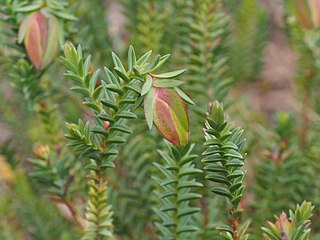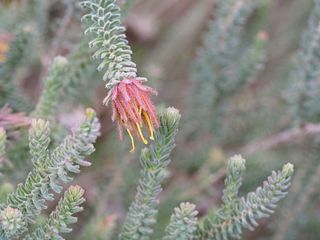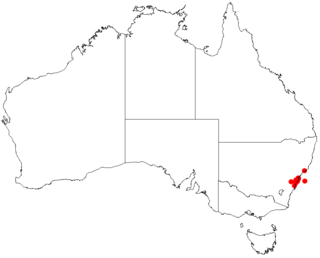
Darwinia, sometimes commonly known as mountain bells or simply bells, is a genus of about 70 species of evergreen shrubs in the family Myrtaceae, endemic to southeastern and southwestern Australia. The majority are native to southern Western Australia, but a few species occur in South Australia, New South Wales and Victoria. The genus was named in honour of Erasmus Darwin, grandfather of Charles Darwin by Edward Rudge in 1816. Most darwinias grow to a height of between 0.2 and 3 m, and many are prostrate shrubs. Most have small, simple leaves and the flowers are often grouped together, each flower with five red, white or greenish petals and ten stamens. In many species, the flowers are surrounded by large, colourful bracts, giving rise to their common names.

Darwinia citriodora, commonly known as lemon-scented darwinia or lemon scented myrtle, is a plant in the myrtle family Myrtaceae and is endemic to the south-west of Western Australia. It is a shrub with oblong to lance-shaped leaves and red, yellow and orange flowers over an extended period. It is a hardy plant in well-drained soil, is often cultivated and used as a rootstock for less hardy species.

Darwinia glaucophylla is a plant in the myrtle family Myrtaceae which grows as a prostrate shrub, sometimes forming extensive mats. It has bluish green leaves and white flowers in small groups which fade to reddish pink as they age. It is only known from about fifteen sites in the Gosford area and is listed as "threatened" in New South Wales legislation.

Darwinia fascicularis is shrub in the myrtle family and is endemic to areas near Sydney. A small shrub with aromatic foliage and white flowers, turning red as they mature. Nectar feeding birds are attracted to its flowers as a food source.

Eriostemon australasius commonly known as pink wax flower is a plant in the citrus family Rutaceae and is endemic to eastern Australia. It is an erect, bushy shrub with narrow oblong leaves and pink flowers with five petals in late winter and early spring.

Epacris microphylla , commonly known as coral heath, is a plant in the heath family Ericaceae and which is endemic to eastern Australia. It is a common, wiry shrub with tiny leaves that are often obscured by the flowers, especially near the ends of the stems. The plant sometimes grows in dense groups, giving the effect of a snowfall.

Darwinia briggsiae is a plant in the myrtle family Myrtaceae and is endemic to New South Wales. It is an erect shrub with linear-shaped leaves and small groups of pink and white flowers.

Darwinia apiculata, commonly known as the scarp darwinia, is a plant in the myrtle family Myrtaceae and is endemic to a small area in Western Australia. It is a rounded, densely branched, small shrub with thin red branches and scattered small leaves. The flowers are arranged in small groups on the ends of the branches, their most obvious feature being long, red, pointed bracts surrounding each flower and a longer red style with scattered hairs near its tip.

Darwinia biflora is a plant in the myrtle family Myrtaceae and is endemic to New South Wales. It is an erect, often straggly shrub with flattened, glabrous leaves, and flowers which are arranged in pairs. The flowers are greenish in colour but each is surrounded by two purple-red bracteoles and have a long yellow-green style projecting out of the flower tube. The species only occurs in the Sydney region in a few places where shale-capped ridges intergrade with Hawkesbury sandstone.

Darwinia camptostylis is a plant in the myrtle family Myrtaceae and is endemic to New South Wales and Victoria. It is small shrub with flattened, glabrous leaves and small clusters of green to yellow flowers. There are scattered populations in coastal areas where the plants grow in heath.

Darwinia capitellata is a plant in the myrtle family Myrtaceae and is endemic to the south-west of Western Australia. It is a bushy, many-branched shrub, very similar to Darwinia diosmoides but differs in the arrangement of its flowers, its more branched habit, prominent oil glands on the younger stems and its thinner, paper-like bracteoles. It was first discovered as a separate species when specimens of it were found to have a larger chromosome number than specimens of D. diosmoides.

Darwinia carnea, commonly known as Mogumber bell or Narrogin bell, is a species of flowering plant in the myrtle family Myrtaceae and is endemic to the south-west of Western Australia. It is a small shrub with narrow, keeled leaves and flowers in groups of about eight, surrounded by yellowish-green to pinkish-red bracteoles. It occurs in small, isolated populations near the towns which contribute to its common names. It is the only "bell-flowered" Darwinia to not grow in the Stirling Range National Park.

Darwinia chapmaniana, commonly known as Chapman's bell or Eganu bell, is a plant in the myrtle family Myrtaceae, and is endemic to the south-west of Western Australia. It is a low, rounded, spreading shrub with greyish, hairy leaves and flowers in heads of about 14 small, tubular flowers. The heads are surrounded by long, reddish-yellow, hairy bracts.

Darwinia wittwerorum, commonly known as Wittwer's darwinia, is a plant in the myrtle family Myrtaceae and is endemic to a small area in Western Australia. An erect, spindly shrub with fine leaves and hanging groups of flowers surrounded by leaf-like bracts, it is one of the darwinias known as mountain bells.

Darwinia acerosa, commonly known as the fine-leaved darwinia, is a plant in the myrtle family Myrtaceae and is endemic to a small area in south-west of Western Australia. It is a densely branched, heath-like shrub with crowded, finely pointed leaves and drooping heads of forty to fifty yellowish-green flowers.

Darwinia ferricola, commonly known as the Scott River darwinia, is a plant in the myrtle family Myrtaceae and is endemic to a small area in Western Australia. It is a rounded, densely branched shrub with crowded, linear leaves mostly only on younger branches. The flowers are greenish-yellow and red, and arranged in groups on the ends of the branches, with a long white or reddish style protruding from the petal tube.

Darwinia pimelioides is a species of flowering plant in the family Myrtaceae and is endemic to the southwest of Western Australia. It is an erect shrub with broadly oblong leaves and heads of drooping flowers surrounded by larger red to pink and green bracts.
Darwinia terricola, commonly known as the Blackwood bell, is a plant in the myrtle family Myrtaceae and is endemic to a small area in the south-west of Western Australia. It is a small, low, sometimes prostrate shrub with small, linear leaves and small groups of flowers surrounded by reddish-green bracts and which usually lie on the ground.

Darwinia diminuta is a plant in the myrtle family Myrtaceae and is endemic to New South Wales. A small spreading shrub with white to pinkish tubular flowers arranged in pairs, with a restricted distribution mostly in the Sydney region.

Darwinia leptantha is a flowering plant in the family Myrtaceae. It is an upright, small shrub with white flowers turning pink with age, triangular-shaped leaves and is endemic to New South Wales.




















